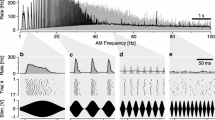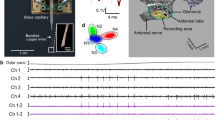Abstract
-
1.
We developed a high resolution, on-line stimulus measurement system for accurate control of chemical stimulus applications for Homarus americanus lateral antennule chemoreceptors. Focal stimulus presentations in an electrophysiological preparation with the receptor sensilla intact were measured at small spatial (30 μm) and time (5 ms) scales.
-
2.
We tested 15 receptor cells with ten 100 ms pulses of 104 M hydroxyproline at 0.5, 1, 2 and 4 Hz and with a single 8 s square pulse. Individual cells showed differences in their capabilities to resolve pulses (“flicker fusion”). At 2 Hz stimulation, some cells could follow stimulus pulses while others could not. At 4 Hz, 3 cells could still encode individual stimulus pulses accurately. The population resolved pulses up to 2 Hz; at 4 Hz, the population response to a pulse series approximated the response to a square pulse.
-
3.
Repetitive stimulation caused a gradual decrease in the number of spikes and a gradual increase in first spike latency (“cumulative adaptation”). Increased stimulation frequency resulted in greater cumulative adaptation.
-
4.
Since individual differences in adaptation and disadaptation rates of the receptor cells could not be attributed to measured stimulus variability in situ, lobster chemoreceptor cell populations have intrinsic temporal diversity which, we hypothesize, could be used to analyze pulsatile stimuli that occur in natural turbulent odor plumes.
Similar content being viewed by others
Abbreviations
- ASW:
-
artificial sea water
- Hyp:
-
hydroxyproline
- IVEC:
-
In Vivo Electrochemistry Computer system
References
Almaas TJ, Christensen TA, Mustaparta H (1991) Chemical communication in heliothine moths. I. Antennal receptor neurons encode several features of intra- and interspecific odorants in the male corn earworm moths Helicoverpa zea. J Comp Physiol A 169:249–258
Atema J (1985) Chemoreception in the sea: adaptations of chemoreceptors and behaviour to aquatic stimulus conditions. Soc Exp Biol Symp 39:387–423
Atema J (1987) Aquatic and terrestrial chemoreceptor organs: morphological and physiological designs for interfacing with chemical stimuli. In: Dejours P, Bolis L, Taylor CR, Weibel ER (eds) Comparative physiology: life in water and on land. IX. Liviana Press, Padova, pp 303–316
Baker TC, Willis MA, Haynes KF, Phelan PL (1985) A pulsed cloud of pheromone elicits upwind flight in male moths. Physiol Entomol 10:257–265
Bayer TA, McClintock TS, Grünert U, Ache BW (1989) Histamineinduced modulation of olfactory receptor neurones in two species of lobster, Panulirus argus and Homarus americanus. J Exp Biol 145:133–146
Berg K, Voigt R, Atema J (1992) Flicking in the lobster Homarus americanus: recordings from electrodes implanted in antennular segments. Biol Bull 183:377–378
Boekhoff I, Breer H (1992) Termination of second messenger signalling in olfaction. Proc Natl Acad Sci USA 89:471–474
Borroni PF, Atema J (1988) Adaptation in chemoreceptor cells. I. Self-adapting backgrounds determine threshold and cause parallel shift of response function. J Comp Physiol A 164:64–74
Breer H, Boekhoff I, Tareilus E (1990) Rapid kinetics of second messenger formation in olfactory transduction. Nature 345:65–68
Carr WES, Gleeson RA, Trapido-Rosenthal HG (1990) The role of perireceptor events in chemosensory processes. Trends Neurosci 13:212–215
Chaput MA, Holley A (1985) Responses of olfactory bulb neurons to repeated odor stimulations in awake freely-breathing rabbits. Physiol Behav 34:249–258
Christensen TA, Hildebrand JG (1988) Frequency coding by central olfactory neurons in the sphinx moth Manduca sexta. Chem Senses 13:123–130
Conner WE, Eisner T, Vander Meer RK, Guerrero A, Ghiringelli D, Meinwald J (1980) Sex attractant of an Arctiid moth (Utetheisa ornatrix): a pulsed chemical signal. Behav Ecol Sociobiol 7:55–63
Dethier VG (1968) Chemosensory input and taste discrimination in the blowfly. Science 161:398–391
Devine DV, Atema J (1982) Function of chemoreceptor organs in spatial orientation of the lobster Homarus americanus: differences and overlap. Biol Bull 163:144–153
Døving KB (1987) Response properties of neurones in the rat olfactory bulb to various parameters of odour stimulation. Acta Physiol Scand 130:285–298
Firestein S, Shepherd GM, Werblin FS (1990) Time course of the membrane current underlying sensory transduction in salamander olfactory receptor neurones. J Physiol (Lond) 430:135–158
Getchell TV, Margolis FL, Getchell ML (1984) Perireceptor and receptor events in vertebrate olfaction. Prog Neurobiol 23:317–345
Gleeson RA, Carr WES, Trapido-Rosenthal HG (1993) Morphological characteristics facilitating stimulus access and removal in the olfactory organ of the spiny lobster, Panulirus argus: insight from the design. Chem Senses 18:67–75
Goldberg JM, Brown PB (1969) Response of binaural neurons of dog superior olivary complex to dichotic tonal stimuli: some physiological mechanisms of sound localization. J Neurophysiol 32:613–636
Gomez G, Voigt R, Atema J (1992) High resolution measurement and control of chemical stimuli in the lateral antennule of the lobster Homarus americanus. Biol Bull 183:353–354
Gomez G, Voigt R, Atema J (1993) Effects of stimulus concentration on frequency coding in lobster chemoreceptor cells. Chem Senses 18:561–562
Govind CK, Lang F (1981) Physiological identification and asymmetry of lobster claw closer motoneurons. J Exp Biol 94:329–339
Hefti F, Felix D (1983) Chronoamperometry in vivo: does it interfere with spontaneous neuronal activity in the brain? J Neurosci Meth 7:151–156
Johnson BR, Atema J (1983) Narrow-spectrum chemoreceptor cells in the antennules of the American lobster, Homarus americanus. Neurosci Lett 41:145–150
Johnson BR, Voigt R, Atema J (1989) Response properties of lobster chemoreceptor cells: response modulation by stimulus mixtures. Physiol Zool 62:559–579
Kaissling K-E (1986) Temporal characteristics of pheromone receptor cell responses in relation to orientation behaviour of moths. In: Payne TL, Birch MC, Kennedy CEJ (eds) Mechanisms in insect olfaction. University Press, Oxford, pp 193–200
Kauer J, Shepherd G (1975) Olfactory stimulation with controlled and monitored step pulses of odor. Brain Res 85:108–113
Kelling ST, Halpern BP (1986) The physical characteristics of open flow and closed flow taste delivery apparatus. Chem Senses 11:89–104
Kramer E (1986) Turbulent diffusion and pheromone triggered anemotaxis. In: Payne TL, Birch MC, Kennedy CEJ (eds) Mechanisms in insect olfaction. University Press, Oxford, pp 59–67
Laing DG, MacLeod P (1992) Reaction time for the recognition of odor quality. Chem Senses 17:337–346
Margolis J (1969) A versatile gradient-generating device. Anal Biochem 27:319–322
Margolis SE (1985) Effect of rhythmic and tonic stimulation of neuron activity in the olfactory bulb of the newt Triturus cristatus. J Evol Biochem Physiol 20:395–402
Marion-Poll F, Tobin TR (1992) Temporal coding of pheromone pulses and trains in Manduca sexta. J Comp Physiol A 171:505–512
McBurney D (1976) Temporal properties of the human taste system. Sensory Processes 1:150–162
Michel WC, McClintock TS, Ache BW (1991) Inhibition of lobster olfactory receptor cells by an odor-activated potassium conductance. J Neurophysiol 65:446–453
Moore PA, Atema J (1988) A model of a temporal filter in chemoreception to extract directional information from a turbulent odor plume. Biol Bull 17:355–363
Moore PA, Atema J (1991) Spatial information in the three-dimensional fine structure of an aquatic odor plume. Biol Bull 181:408–418
Moore PA, Gerhardt GA, Atema J (1989) High resolution spatiotemporal analysis of aquatic chemical signals using microelectrochemical electrodes. Chem Senses 14:829–840
Moore PA, Atema J, Gerhardt GA (1991a) Fluid dynamics and microscale chemical movement in the chemosensory appendages of the lobster, Homarus americanus. Chem Senses 16:663–674
Moore PA, Scholz N, Atema J (1991b) Chemical orientation of lobsters, Homarus americanus, in turbulent odor plumes. J Chem Ecology 17:1293–1307
Moore PA, Zimmer-Faust RK, BeMent SL, Weissburg MJ, Parrish JM, Gerhardt GA (1992) Measurement of microscale patchiness in a turbulent aquatic odor plume using a semiconductor-based microprobe. Biol Bull 183:138–142
Murlis J, Elkinton JS, Carde RT (1992) Odor plumes and how insects use them. Annu Rev Entomol 37:505–532
Murlis J, Jones CD (1981) Fine-scale structure of odour plumes in relation to insect orientation to distant pheromone and other attractant sources. Physiol Entomol 6:71–86
Reeder PB, Ache BW (1980) Chemotaxis in the Florida spiny lobster, Panulirus argus. Anim Behav 28:831–839
Rumbo E, Kaissling K-E (1989) Temporal resolution of odour pulses by three types of pheromone receptor cells in Antheraea polyphemus. J Comp Physiol A 165:281–291
Schild D (1985) A computer-controlled device for the application of odours to aquatic animals. J Electrophysiol Tech 12:71–79
Schmiedel-Jakob I, Anderson PAV, Ache BW (1989) Whole cell recording from lobster olfactory receptor cells: responses to current and odor stimulation. J Neurophysiol 61:994–1000
Schmitt BC, Ache BW (1979) Olfaction: responses of a decapod crustacean are enhanced by flicking. Science 205:204–206
Vogel S (1981) Life in moving fluids. Princeton University Press, New Jersey
Voigt R, Atema J (1988) Effects of stimulus profile on temporal response profile and disadaptation time course. Chem Senses 13:742
Voigt R, Atema J (1990) Adaptation in chemoreceptor cells. III. Effects of cumulative adaptation. J Comp Physiol A 166:865–874
Zack Strausfeld C, Kaissling K-E (1986) Localized adaptation processes in olfactory sensilla of Saturniid moths. Chem Senses 11:499–512
Author information
Authors and Affiliations
Rights and permissions
About this article
Cite this article
Gomez, G., Voigt, R. & Atema, J. Frequency filter properties of lobster chemoreceptor cells determined with high-resolution stimulus measurement. J Comp Physiol A 174, 803–811 (1994). https://doi.org/10.1007/BF00192730
Accepted:
Issue Date:
DOI: https://doi.org/10.1007/BF00192730




